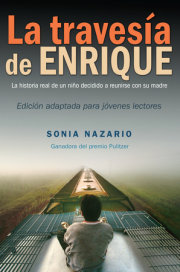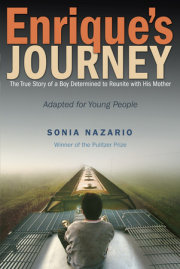In this astonishing true story, award-winning journalist Sonia Nazario recounts the unforgettable odyssey of a Honduran boy who braves unimaginable hardship and peril to reach his mother in the United States.
Selected for common reading at:
Colleges and Universities:
• Adams State College, Alamosa, CO
• Allegheny College, Meadville, PA
• Arcadia University, Glenside, PA
• Baldwin-Wallace College, Berea, OH
• Birmingham Southern College, Birmingham, AL
• Bluffton University, Bluffton, OH
• Bunker Hill Community College, Boston, MA
• Butler University, Indianapolis, IN
• Cabrini College, Radnor Township, PA
• California Lutheran University, Thousand Oaks, CA
• California State University, Bakersfield, CA
• Catawba Valley Community College, Hickory, NC
• Cedar Valley College, Lancaster, TX
• Central College, Pella, IA
• Chandler-Gilbert Community College, Maricopa County, AZ
• College of Mount St. Joseph, Cincinnati, OH
• College of Saint Mary, Omaha, NE
• College of Wooster, Wooster, OH
• Cuesta College, San Luis Obispo, CA
• Cumberland County College, Vineland, NJ
• East Carolina University, Greenville, NC
• Eckerd College, St. Petersburg, FL
• Edgewood College, Madison, WI
• Florida Southern College, Lakeland, FL
• Fort Lewis College, Durango, CO
• Fullerton College, Fullerton, CA
• George Fox University, Newberg, OR
• Georgia Southern University, Statesboro, GA
• Georgia State University, Atlanta, GA
• Gustavus Adolphus College, St. Peter, MN
• Hawai'i Pacific University, Honolulu, HI
• Henderson State University, Arkadelphia, AR
• Hesston College, Hesston, KS
• Holy Names University, Oakland, CA
• Idaho State University, Pocatello, ID
• Indiana University, Kokomo, IN
• Jacksonville University, Jacksonville, FL
• John Carroll University, University Heights, OH
• Lasell College, Newton, MA
• Loyola University Chicago, Chicago, IL
• Manhattan College, New York, NY
• Massachusetts College of Liberal Arts, North Adams, MA
• Meredith College, Raleigh, NC
• Metro State College, Denver, CO
• Metropolitan Community College, Omaha, NE
• Metropolitan Community College-Penn Valley, Kansas City, MO
• Michigan State University, East Lansing, MI
• Millersville University, Millersville, PA
• Missouri State University, Springfield, MO
• Moberly Area Community College, Moberly, MO
• Moorpark College, Moorpark, CA
• Mount St. Joseph University, Cincinnati, OH
• Nassau Community College, Garden City, NY
• Newman University, Wichita, KS
• North Seattle Community College, Seattle, WA
• Northern Arizona University, Flagstaff, AZ
• Notre Dame de Namur University, Belmont, CA
• Peace College, Raleigh, NC
• Pennsylvania State University, Harrisburg, PA
• Pierce College, Woodland Hills, CA
• Ramapo College of New Jersey, Mahwah, NJ
• Rider University, Lawrenceville, NJ
• Rockhurst University, Kansas City, MO
• Rosemont College, Rosemont, PA
• Saint Louis University, Saint Louis, MO
• Sam Houston State University, Huntsville, TX
• Santa Barbara City College, CA
• Sonoma State University, Rohnert Park, CA
• Southwestern College, Chula Vista, CA
• SUNY College at Old Westbury, NY
• Texas A & M University, College Station, TX
• Union Theological Seminary, New York, NY
• University of California, Santa Barbara, CA
• University of La Verne, La Verne, CA
• University of Missouri, Kansas City, MO
• University of New Mexico, Albuquerque, NM
• University of New Orleans, New Orleans, LA
• University of North Carolina, Charlotte, NC
• University of North Carolina, Greensboro, NC
• University of Northern Iowa, Cedar Falls, IA
• University of Richmond, Richmond, VA
• University of South Carolina, Aiken, SC
• University of Wisconsin, La Crosse, WI
• University of Wisconsin, Madison, WI
• University of Wisconsin, Whitewater, WI
• Utah Valley University, Orem, UT
• Valparaiso University, Valparaiso, IN
• Williams College, Williamstown, MA
• Wingate University, Wingate, NC
High Schools:
• Academy of Education and Empowerment at Carson High School, Carson, CA
• Academy of the Holy Angels, Demarest, NJ
• Andover eCademy, Andover, KS
• Animo Venice Charter High School, Venice, CA
• Atlantic Technical Center High School, Margate, FL
• Banning High School, Wilmington, CA
• Bay Shore High School, Bay Shore, NY
• Bishop Mora Salesian College Preparatory High School, Los Angeles, CA
• Brother Martin High School, New Orleans, LA
• Burlingame High School, Burlingame, CA
• Challenge Early College High School, Houston, TX
• Chatham High School, Chatham, NJ
• Cheverus High School, Portland, ME
• Christian Brothers High School, Sacramento, CA
• Colorado Academy, Denver, CO
• Conner High School, Hebron, KY
• Desert Mirage High School, Thermal, CA
• Dobyns-Bennett High School, Kingsport, TN
• Elk Grove High School, Elk Grove, IL
• Environmental Science and Technology High School, Los Angeles, CA
• Esteban E. Torres High School, Los Angeles, CA
• Fletcher High School Cambridge AICE Program, Jacksonville, FL
• Gates County High School, Gatesville, NC
• Harpeth Hall School, Nashville, TN
• Haverford High School, Havertown, PA
• Hayfield Secondary School, Alexandria, VA
• Hudson High School, Hudson, OH
• Huntington High School, Huntington, NY
• Immaculate Conception Academy, San Francisco, CA
• Incline Village Schools, Incline Village, NV
• Jack C. Hayes High School, Buda, TX
• Jackson School District, Jackson, NJ
• John Muir High School, Pasadena, CA
• Johns Creek High School, Johns Creek, GA
• Johnson High School, San Antonio, TX
• Keansburg Public Schools, Keansburg, NJ
• Kellam High School, Virginia Beach, VA
• La Jolla Country Day School, La Jolla, CA
• La Salle High School of Yakima, Yakima, WA
• Lake View High School, Chicago, IL
• Lakeview High School, Chicago, IL
• Los Alamitos High School, Los Alamitos, CA
• Los Angeles Leadership Academy, Los Angeles, CA
• Mamaroneck High School, Mamaroneck, NJ
• Manheim Central High School, Manheim, PA
• Marian High School, Omaha, NE
• Marquette University High School, Milwaukee, WI
• Mercy High School, Omaha, NE
• Middletown N.J. High School
• Nazareth Academy, LaGrange Park, IL
• Niles North High School District 219, Skokie, IL
• North East Independent High School, San Antonio, TX
• North East Independent School District, San Antonio, TX
• North High School, Sioux City, IA
• Northern Valley High School District, NJ
• Northern Valley Regional High School, Demarest, NJ
• Northern Valley Regional High School, Old Tappan, NJ
• Notre Dame High School, San Jose, CA
• O'Fallon Township High School, O'Fallon, IL
• Olympian High School, Chula Vista, CA
• Pebblebrook High School, Mableton, GA
• Putnam County High School, Eatonton, GA
• Round Rock High School, Round Rock, TX
• Santa Ana High School, Santa Ana, CA
• Santa Monica High School, Santa Monica, CA
• Social Justice Humanitas Academy, San Fernando, CA
• St. Ignatius High School, Cleveland, OH
• St. Mary's School, Raleigh, NC
• St. Raymond High School for Boys, Bronx, NY
• University School of Milwaukee, Milwaukee, IL
• Upper Cape Cod Regional Technical School, Bourne, MA
• Watchung Hills Regional High School, Warren, NJ
• Wheeling High School, Wheeling, IL
• White Plains High School, White Plains, NY
• Woodrow Wilson High School, Washington DC
• Academy of Information Technology & Engineering, Stamford, CT
• Brebeuf Jesuit Preparatory, Indianapolis, IN
• Brewster High School, Brewster, NY
• Brooks School, MA
• Brown Summer High School
• Catalina Foothills High School, Tucson, AZ
• Centreville High School, Clifton, VA
• Coachella Valley High School, Thermal, CA
• Costa Mesa High School, Costa Mesa, CA
• Flower Mound High School, Flower Mound, TX
• Fort Morgan High School, Fort Morgan, CO
• Friends Seminary, New York City, NY
• Glenbard East High School, Lombard, IL
• Head-Royce School, Oakland, CA
• Helix Charter High School, San Diego, CA
• High Point High School, Beltsville, MD
• Hopewell Valley Regional School District, Pennington, NJ
• International School of Louisiana, New Orleans
• Marcus High School & Marcus 9th Grade Campus, Flower Mound, TX
• Martin Luther King High School, Nashville, TN
• Newburyport High School, Newburyport, MA
• Ronald Reagan Senior High School, Miami, FL
• Seven Hills School, Walnut Creek, CA
• St. Francis DeSales, Columbus, Ohio
• Watchung Hills High School, Warren Township, NJ
Middle School [Young Adult Version]
• Durango Middle School, Durango, CO
• Edward Brooke Charter School, Roslindale, MA
• Escalante Middle School, Durango, CO
• James Denman Middle School, San Francisco, CA
• James Lick Middle School, San Francisco, CA
• Lake Travis Middle School, Austin, TX
• McDonough Expeditionary Learning School, Hartford, CT
• Miller Middle School, Durango, CO
• Saint John's Preparatory School, Collegeville, MN
• The Benjamin School, North Palm Beach, FL
• Youth Policy Institution, Los Angeles, CA
Enrique’s Journey has been adopted as a “One City, One Book” by:
• San Diego, CA 2007
• Yuma, AZ 2008
• Glendale, CA 2008
• Santa Fe Springs, CA 2009
• Saint Peter, MN 2009
• Laredo, TX 2009
• Memphis, TN 2010
• Denver, CO 2012
• Davis, CA 2013
• Watsonville, CA 2013
• Wyoming, MI 2014
• Bakersfield, CA and Kern County, CA 2014
• Rhinelander, WI 2014
• Naperville, IL 2015
• Peoria, IL 2015
• Nantucket, MA 2015
• Northfield, MN, 2015
• Lakeville, MN 2015
• Stark County, ND 2015 (Young Adult Edition)
• East Lansing, MI 2016
When Enrique is five years old, his mother, Lourdes, too poor to feed her children, leaves Honduras to work in the United States. The move allows her to send money back home to Enrique so he can eat better and go to school past the third grade.
Lourdes promises Enrique she will return quickly. But she struggles in America. Years pass. He begs for his mother to come back. Without her, he becomes lonely and troubled. When she calls, Lourdes tells him to be patient. Enrique despairs of ever seeing her again. After eleven years apart, he decides he will go find her.
Enrique sets off alone from Tegucigalpa, with little more than a slip of paper bearing his mother’s North Carolina telephone number. Without money, he will make the dangerous and illegal trek up the length of Mexico the only way he can–clinging to the sides and tops of freight trains.
With gritty determination and a deep longing to be by his mother’s side, Enrique travels through hostile, unknown worlds. Each step of the way through Mexico, he and other migrants, many of them children, are hunted like animals. Gangsters control the tops of the trains. Bandits rob and kill migrants up and down the tracks. Corrupt cops all along the route are out to fleece and deport them. To evade Mexican police and immigration authorities, they must jump onto and off the moving boxcars they call El Tren de la Muerte–The Train of Death. Enrique pushes forward using his wit, courage, and hope–and the kindness of strangers. It is an epic journey, one thousands of immigrant children make each year to find their mothers in the United States.
Based on the Los Angeles Times newspaper series that won two Pulitzer Prizes, one for feature writing and another for feature photography, Enrique’s Journey is the timeless story of families torn apart, the yearning to be together again, and a boy who will risk his to find the mother he loves.
“One of the main goals of our college’ s Common Reading Experience is to light a fire in our students’ brains about an important subject that they will have the ability to impact in their lifetime. As immigration is one of those subjects, we chose to give our almost 900 freshmen a free copy of Enrique’s Journey this fall. Our students at FLC are reading all or part of the book in several classes. We invited the book’s author, Sonia Nazario, to give a public talk and to spend a full day with students, faculty, staff, and members of the larger Durango community. While I am embarrassed that we asked so much of Sonia, she didn’ t flinch. She understood that we are trying to get our students engaged in the topic of immigration, motivated to learn, and willing to act as responsible citizens. She dove in and lit that fire! All around campus, our students are saying: I had NO idea! Students are remarking on her ability to make a dense, complicated subject easier for them to begin to understand. They are impresses by her intelligence and her huge heart and passion for her work. I, and my colleagues, wish Sonia had stayed at the college longer. We would all benefit from more of her wisdom and we liked being so energized! We are lucky she came here.” –Bridget Irish, Assistant Dean, Writing and First Year Experience, Fort Lewis College
For additional educator guides and materials, go to: http://enriquesjourney.com/educators.html











